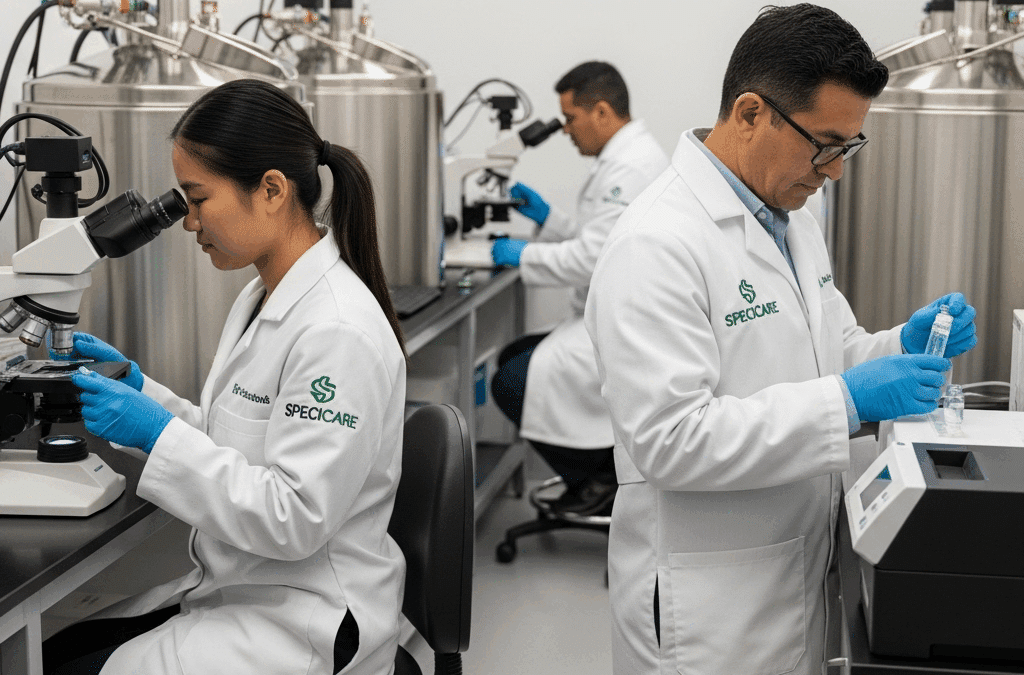Once your tumor tissue is successfully cryopreserved, it enters a state of suspended animation, essentially “on pause” until it’s needed. The purpose of this advanced preservation method is to unlock a wide range of advanced options for your current and future cancer care, as well as to contribute to broader scientific understanding of cancer.
Here’s what generally happens and how it can be utilized:
1. Secure Long-Term Storage:
- Your cryopreserved tumor tissue is stored at ultra-low temperatures, typically in liquid nitrogen tanks (-196°C). At these temperatures, all biological processes cease, ensuring that the tissue remains viable and genetically stable for potentially decades.
- This storage is secure, typically in specialized facilities like biobanks, to protect the integrity of your valuable sample.
2. Availability for Future Use of Tumor Tissue (Patient-Directed):
The primary benefit of preserving your tumor tissue with a service like SpeciCare is that you retain ownership and control over how that tissue is used. This is a key differentiator from standard pathology samples, which typically become the property of the institution.
This control allows for:
- No Time Pressure: You don’t have to decide immediately how you want to use the tissue. It’s stored safely, giving you time to research options, consult with different specialists, or wait for new scientific breakthroughs.
- Access to Advanced Testing & Therapies: This is the core value. Your viable tumor tissue can be “woken up” and used for a variety of cutting-edge applications:
- Personalized Drug Sensitivity Testing (Ex Vivo):
- Organoid Culture: One of the most promising applications is the growth of “organoids” (mini-tumors) from your preserved tissue. These are 3D cell cultures that closely mimic the structure, genetic makeup, and behavior of your original tumor.
- Drug Screening: These organoids can then be exposed to various chemotherapy drugs, targeted therapies, and experimental compounds in a lab setting. This allows researchers to see which treatments are most effective at killing your specific cancer cells before those drugs are administered to you. This can guide your oncologist toward the most promising treatments, potentially avoiding ineffective therapies and their associated side effects.
- Testing Combinations: Organoids can also be used to test combinations of drugs to find synergistic effects.
- Advanced Molecular Profiling:
- High-Quality DNA/RNA Extraction: Cryopreserved tumor tissue is ideal for extracting high-quality, undegraded DNA and RNA. This enables comprehensive genomic (DNA), transcriptomic (RNA), and proteomic (protein) sequencing and analysis.
- Identifying Driver Mutations & Biomarkers: This detailed profiling can identify specific mutations, gene fusions, protein expressions, and other biomarkers unique to your tumor, which can then be targeted by precision medicine drugs or inform your prognosis.
- Understanding Tumor Evolution: If you have future biopsies, your cryopreserved initial tumor can be compared to later samples to understand how your cancer is changing over time or developing resistance to treatments.
- Personalized Immunotherapies:
- Anti-Cancer Vaccines: Your specific tumor cells contain unique antigens. Cryopreserved tissue can be used to develop personalized anti-cancer vaccines that train your immune system to recognize and attack your tumor cells.
- T-Cell Based Therapies (e.g., TIL Therapy, CAR-T modifications): These therapies often require live tumor cells or components to educate or engineer your immune cells to fight your cancer.
- Access to Clinical Trials: Having your tumor tissue preserved can make you eligible for specific clinical trials that require viable tissue for correlative studies or for developing trial-specific therapies.
- Personalized Drug Sensitivity Testing (Ex Vivo):
3. Contribution to Research (With Your Consent):
- Beyond direct patient benefit, your anonymized and de-identified cryopreserved tissue (with your explicit consent) can contribute immensely to broader cancer research. This includes:
- Developing new diagnostic tools.
- Discovering new drug targets.
- Understanding cancer heterogeneity and resistance mechanisms across populations.
- Validating new research models.
In essence, after cryopreservation, your tumor tissue becomes a living, personal research tool. It empowers you and your medical team with unprecedented opportunities to understand your specific cancer and tailor future treatments, moving beyond a one-size-fits-all approach.

Recent Comments